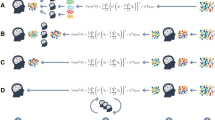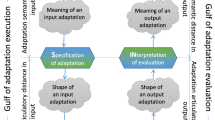Abstract
In this paper we examine the growing interest in personalized user interfaces and explore the potential of machine learning in meeting that need. We briefly review progress in developing fielded applications of machine learning, then consider some characteristics of adaptive user interfaces that distinguish them from more traditional applications. After 1655 06 this, we consider some examples of adaptive interfaces that use inductive methods to personalize their behavior, and we report some ongoing research that extends these ideas in the automobile environment.
Preview
Unable to display preview. Download preview PDF.
Similar content being viewed by others
References
Anderson, J. R. (1984). Cognitive psychology and intelligent tutoring. Proceedings of the Sixth Conference of the Cognitive Science Society (pp. 37–43). Boulder, CO: Lawrence Erlbaum.
Baffes, P. T., & Mooney, R. J. (1995). A novel application of theory refinement to student modeling. Proceedings of the Thirteenth National Conference of the American Association for Artificial Intelligence (pp. 403–408). Portland, OR: AAAI Press.
Brodley, C. E., & Smyth, P. (1997). Applying classification algorithms in practice. Statistics and Computing, 7, 45–56.
Cypher, A. (1991). Eager: Programming repetitive tasks by example. Proceedings of CHI (pp. 33–39). New Orleans: ACM.
Cypher, A. (Ed.). (1993). Watch what I do: Programming by demonstration. Cambridge, MA: MIT Press.
Dent, L., Boticario, J., McDermott, J., Mitchell, T., & Zaborowski, D. (1992). A personal learning apprentice. Proceedings of the Tenth National Conference on Artificial Intelligence (pp. 96–103). San Jose, CA: AAAI Press.
Evans, B., & Fisher, D. (1994). Overcoming process delays with decision-tree induction. IEEE Expert, 9, 60–66.
Fayyad, U. M., Smyth, P., Weir, N., & Djorgovski, S. (1995). Automated analysis and exploration of image databases: Results, progress, and challenges. Journal of Intelligent Information Systems, 4, 1–19.
Giordana, A., Saitta, L., Bergadano, F., Brancadori, F., & De Marchi, D. (1993). Enigma: A system that learns diagnostic knowledge. IEEE Transactions on Knowledge and Data Engineering, KDE-5, 15–28.
Hermens, L. A., & Schlimmer, J. C. (1994). A machine-learning apprentice for the completion of repetitive forms. IEEE Expert, 9, 28–33.
Hinkle, D., & Toomey, C. N. (1994). Clavier: Applying case-based reasoning to composite part fabrication. Proceedings of the Sixth Innovative Applications of Artificial Intelligence Conference (pp. 55–62). Seattle, WA: AAAI Press.
Lang, K. (1995). NewsWeeder: Learning to filter news. Proceedings of the Twelfth International Conference on Machine Learning (pp. 331–339). Lake Tahoe, CA: Morgan Kaufmann.
Langley, P., & Ohlsson, S. (1984). Automated cognitive modeling. Proceedings of the Fourth National Conference of the American Association for Artificial Intelligence (pp. 193–197). Austin, TX: Morgan Kaufmann.
Langley, P., & Simon, H. A. (1995). Applications of machine learning and rule induction. Communications of the ACM, 38, November, 55–64.
Michie, D. (1989). Problems of computer-aided concept formation. In J. R. Quinlan (Ed.), Applications of expert systems (Vol. 2). Wokingham, UK: Addison-Wesley.
Pazzani, M., Muramatsu, J., & Billsus, D. (1996). Syskill & Webert: Identifying interesting web sites. Proceedings of the Thirteenth National Conference of the American Association for Artificial Intelligence (pp. 54–61). Portland, OR: AAAI Press.
Rogers, S., Langley, P., Johnson, B., & Liu, A. (1997). Personalization of the automotive information environment. Proceedings of the Workshop on Machine Learning in the Real World: Methodological Aspects and Implications (pp. 28–33). Nashville, TN.
Rudström, A. (1995). Applications of machine learning. Licentiate thesis, Department of Computer and Systems Sciences, Stockholm University, Sweden.
Schlimmer, J. C., & Hermens, L. A. (1993). Software agents: Completing patterns and constructing user interfaces. Journal of Artificial Intelligence Research, 1, 61–89.
Author information
Authors and Affiliations
Editor information
Rights and permissions
Copyright information
© 1997 Springer-Verlag Berlin Heidelberg
About this paper
Cite this paper
Langley, P. (1997). Machine learning for adaptive user interfaces. In: Brewka, G., Habel, C., Nebel, B. (eds) KI-97: Advances in Artificial Intelligence. KI 1997. Lecture Notes in Computer Science, vol 1303. Springer, Berlin, Heidelberg. https://doi.org/10.1007/3540634932_3
Download citation
DOI: https://doi.org/10.1007/3540634932_3
Published:
Publisher Name: Springer, Berlin, Heidelberg
Print ISBN: 978-3-540-63493-5
Online ISBN: 978-3-540-69582-0
eBook Packages: Springer Book Archive




